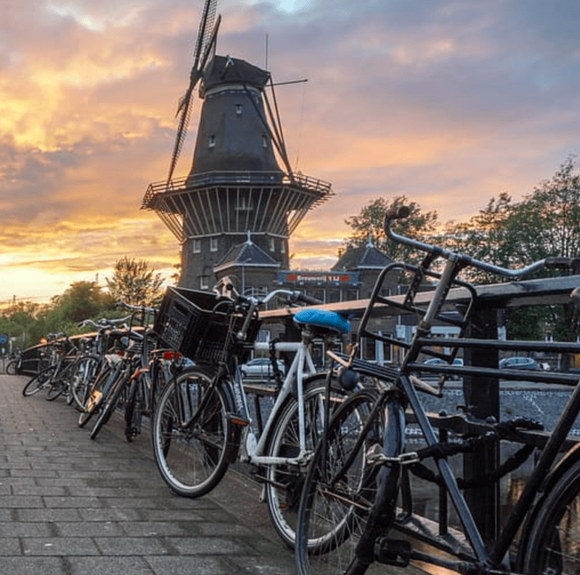The United States has failed to reduce pedestrian and cyclist fatalities as fast as comparably affluent European nations, a new study finds — and the authors think we must employ the same simple, effective policies that they did to catch up in the fight the bloodshed.
Researchers from Virginia Tech and Rutgers University compared the last 28 years of available transportation fatality data from the United States with data from the four countries with the most closely comparable national travel surveys and levels of affluence: Denmark, Germany, Netherlands and the United Kingdom. All four peer nations had reduced per capita pedestrian fatalities by at least 61 percent over the course of the study period — and standout Denmark did so by a whopping 69 percent — but the U.S. reduced ours by just 36 percent.
In other words, our worst peer country's Vision Zero progress was nearly twice as fast as ours in the last three decades. And of course, U.S. pedestrian fatalities actually increased dramatically between 2010 and 2018. Only the U.K. experienced even a moderate increase over the same period — and some U.K. safety experts blame the rise on American-made SUVs.
For people on bikes, U.S. roads haven't been any safer since 1990. Per capita cycling fatalities fell even less in the U.S. than walking deaths, and rose even more dramatically in the last decade. And none of the comparison nations experienced the same surge in the 2010s.
The U.S. cyclist fatality rate is at least 80 percent higher than every peer nation on the list — and in the last two years, it was nearly three times as high as the next most dangerous nation, the United Kingdom.
That's particularly horrifying considering the fact that Americans bike for less than one percent of all trips; the sheer number of bike trips under study in the U.S. was far smaller than any other nation on the list, despite the fact that our population is much larger.

The discrepancies are even more stark for walking. A whopping 11.2 pedestrians died for every 100 million kilometers (or 62 million miles) we walked between 2016 and 2018 — compared to a single death in the Netherlands over the same distance during those years.

So why is the U.S. falling so far behind European nations when it comes to saving lives on our roads? The authors of the study suggested eight possible explanations — all of which will be familiar to Streetsblog readers:
- high average speed limits
- a preponderance of dangerous, car-focused road designs in neighborhoods
- driver-friendly traffic laws
- high rates of drunk and distracted motorists.
But the researchers also explicitly noted that America's addiction to cars probably isn't incurable — and that even if it is, we can save lives through good policy.
"Often, people raise the issue of culture and say, 'Oh well, Americans love cars, and that’s why America is so car-oriented. It’s just not the case in Europe.' I don’t think that’s true," said John Pucher, professor emeritus at Rutgers and co-author on the study. "I spent over three years as a visiting professor in Germany, and let me tell you, Germans are as car-crazy as Americans. Their cars are their babies. They have autobahns with no speed limits. Almost every German has a car. The difference is, these European countries offer people a choice of how to get around. In a lot of U.S. cities, you don't really have options."
Pucher notes that the countries he studied all offer high-quality separated biking and walking infrastructure, good transit, and robust networks of automated enforcement like speed cameras that are backed up by strong and consistent penalties.
"American drivers aren't mean, nasty people," Pucher. "It’s that the police and the courts allow them to get away with murder, frankly. Many American cities actually prohibit the use of speed cameras to catch motorists who are speeding, running red lights, or failing to yield to pedestrians. In Germany and the Netherlands, those cameras are everywhere."
Of course, the European countries in the study have a very different relationship to traffic law enforcement and urban planning than America does, in large part because of our country's unique history of structural racism. In all four EU nations in the paper, over 81 percent of the population identifies as White, compared to just 72 percent of U.S. residents — and none of the Europeans live with precisely the same legacies of slavery, Jim Crow segregation, disparities in police violence against Black people, or the United States' particularly racist applications of urban renewal, red-lining and eminent domain, among other atrocities.
The ongoing weight of that violence in U.S. culture makes cultivating more bike- and walk-friendly places a fundamentally different project than in Europe, especially as the leaders who would be responsible for implementing those changes are still overwhelmingly White, and too often fail to center the voices of communities of color and use transportation reform as a true tool of reparations.
"There is no moving forward without acknowledging this historic and tethered relationship between public space, enforcement and anti-Blackness," wrote planner Amina Yasin. " It is unacceptable for our profession to continue to ignore the I can’t breathe call for life-saving aid from racialized communities being strangled by city planning initiatives and policing."
But Pucher believes that we can catch up to our European counterparts while meaningfully correcting racial inequities — and it starts with quantifying exactly how far we've fallen behind.
"I think it’s absolutely essential for us to explain in a clear, understandable way why we need to make our cities less car dependent," he said. "The political problems are challenging, but we know how to do it."






